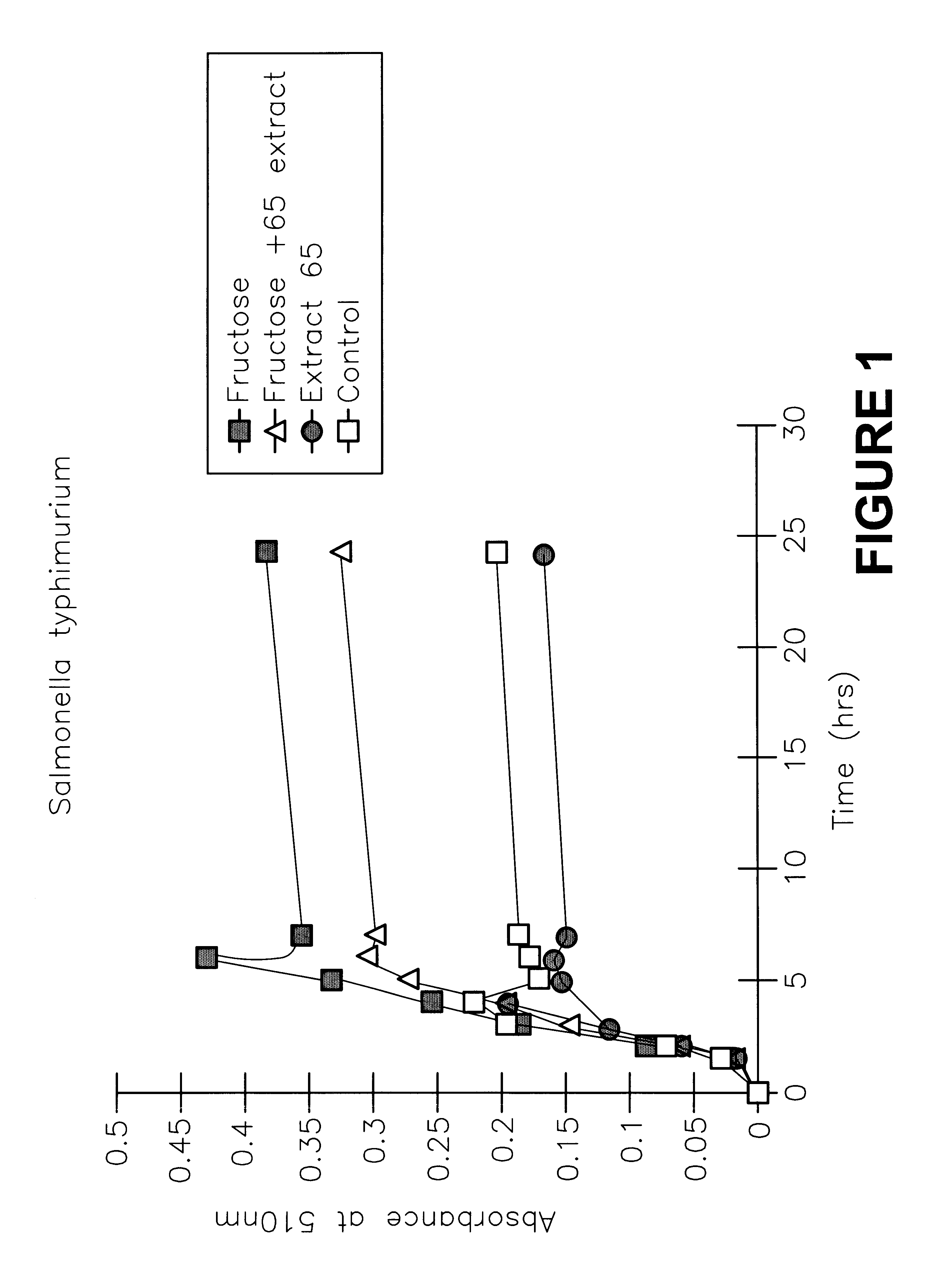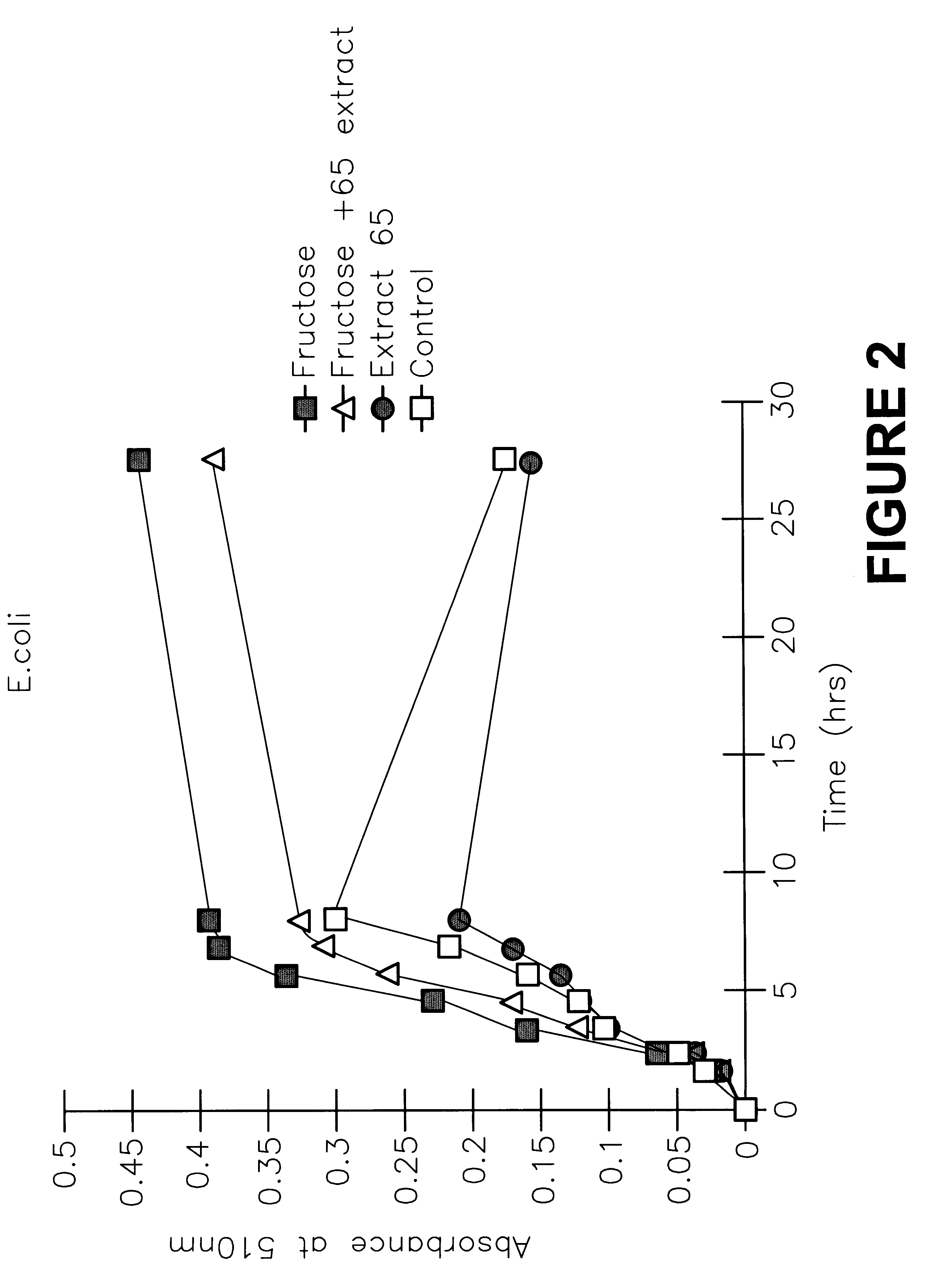Reduction of pathogenic bacteria in food products
a technology of pathogenic bacteria and food products, applied in the direction of coniferophyta medical ingredients, plant/algae/fungi/lichens ingredients, biocide, etc., can solve the problems of salmonella contamination of chicken carcasses during processing, sickness when the product is consumed, and is not typically practical under ordinary conditions decontamination, etc., to reduce the viable bacterial content of food, increase the growth of bifidobacteria, and reduce the growth of bifi
- Summary
- Abstract
- Description
- Claims
- Application Information
AI Technical Summary
Benefits of technology
Problems solved by technology
Method used
Image
Examples
example 1
Inhibition of Bacteria In Vitro Using Larch Extract
In vitro cultures have shown that larch extract at 0.5% concentration completely suppresses the growth of E. coli and of Salmonella typhimurium, respectively. Even in the presence of a good nutrient for both bacteria (viz. fructose), the growth rates of the bacteria are significantly reduced by the extract.
FIGS. 1 and 2 show the growth of E. coli and of Salmonella typhimurium in anaerobic liquid culture with 0.5% additives. Each curve represents the average of 3 experiments. "Extract 65" is a hot water extract of Larix occidentalis wood with the composition described in the disclosure.
The growth curves show that for both bacteria:
a) Growth is suppressed by the extract, compared with the control with no additive. Under these conditions, therefore, the arabinogalactan in the extract does not function as a substrate for growth of the bacteria.
b) Even in the presence of a good growth substrate (fructose) the polyphenol components of the...
example 2
Inhibition of Bacteria by Arabinogalactan in Combination with Polyphenols
Both ultrarefined arabinogalactan and Stractan 10, a Larch tree extract including arabinogalactan and polyphenols, support the growth of Bifidobacteria in culture. Imamura et al., Bifidus-Flores, Fructus et Semina, 6:19-29 (1992) discloses that intestinal bacteria of rats and humans, including Bifidobacterium longum, can metabolize arabinogalactan from Larch. Thus, arabinogalactan from Larch can support the growth of beneficial bacteria such as Bifidobacteria. Other studies have shown that polyphenols extracted from a tree of the genus Larix reduce the growth of harmful bacteria such as Clostridia while permitting the growth of Bifidobacteria.
Larch wood extracts containing both arabinogalactan and polyphenols can concurrently promote the growth of beneficial bacteria, such as Bifidobacteria, and reduce the growth of harmful bacteria such as Clostridia. Thus, an extract derived from wood of a tree of the genus L...
example 3
Examination of the Growth of Six Species of Bifidobacterium on Arabinogalactan from Western Larch in Pure Form and Containing Larch Polyphenols
The bacteria grown on freshly prepared RCA 1.35% agar plates (containing 0.5% fructose) were suspended in 10 ml of RCA broth containing either 0.5% fructose, or 0.5% Stractan 10 or 0.5% ultrarefined arabinogalactan. A control of RCA broth containing no carbon source was also run. The tubes were then placed in a Gas Pak and incubated at 37.degree. C. The growth of bacterial cultures was determined by turbidity. The sign (+) indicates apparent growth on the arabinogalactan sample similar to that observed on fructose.
Purity of bifidobacteria was determined via light microscopy of gram stained organisms and RCA plates containing the chromogen x-a-gal by Chevalier, et al., J. Microbiol. Methods, 13, 75-83 (1991). The results are shown in Table 1.
TABLE 1 Determination of Growth of Bifidobacterium on Arabinogalactan Carbon Sources. Stractan 10 Pure ...
PUM
 Login to View More
Login to View More Abstract
Description
Claims
Application Information
 Login to View More
Login to View More - R&D
- Intellectual Property
- Life Sciences
- Materials
- Tech Scout
- Unparalleled Data Quality
- Higher Quality Content
- 60% Fewer Hallucinations
Browse by: Latest US Patents, China's latest patents, Technical Efficacy Thesaurus, Application Domain, Technology Topic, Popular Technical Reports.
© 2025 PatSnap. All rights reserved.Legal|Privacy policy|Modern Slavery Act Transparency Statement|Sitemap|About US| Contact US: help@patsnap.com


